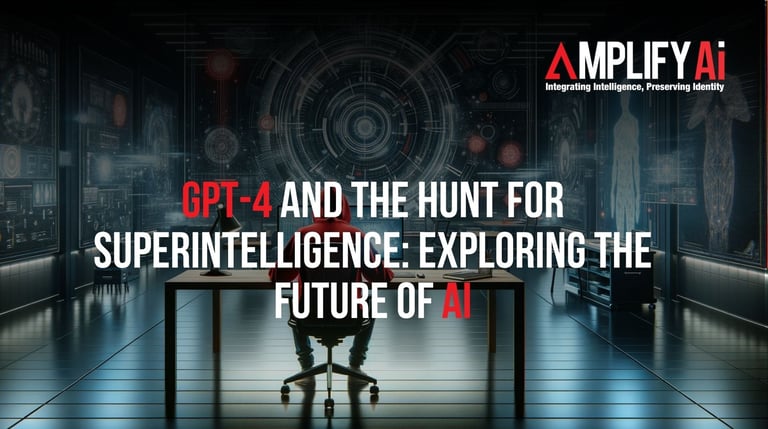GPT-4 and the Hunt for Superintelligence: Exploring the Future of AI
Ronsley Vaz
3 min read


Imagine a world where you have a personal assistant who can write articles, answer customer queries, and even remind you of appointments. This may sound like a scene from a science fiction movie, but with the advancements in artificial intelligence (AI), this futuristic vision is becoming a reality. Meet GPT-4, an AI-powered computer program that uses machine learning to generate human-like text. In this article, we will delve into the fascinating world of GPT-4 and explore its role in the hunt for superintelligence – a form of AI that surpasses the capabilities of the brightest human minds in various fields.
Artificial intelligence is revolutionising the way we live, work, and think. GPT-4, or Generative Pretrained Transformer 4, is at the forefront of this transformation. It represents a significant leap forward in AI capabilities and has the potential to reshape industries, empower small businesses, and even raise profound ethical questions. In this article, we will unravel the basic concepts behind GPT-4, delve into its key components, and explore its real-life applications. Furthermore, we will discuss the implications and risks associated with superintelligence, urging for a responsible and ethical approach to its development.
Machine Learning: Teaching Robots by Example
Machine learning forms the foundation of GPT-4's intelligence. It is akin to teaching a robot by providing it with numerous examples, enabling it to recognise patterns and make predictions. Think of it as a process similar to how you learn to recognise your friend's handwriting over time. GPT-4's ability to learn from data sets the stage for its subsequent capabilities in generating human-like text.
Natural Language Processing: Enabling Machines to Understand Human Language
One of the most remarkable achievements in AI is Natural Language Processing (NLP), which allows machines to comprehend human language. NLP is like teaching a robot to discern the difference between "ice cream" and "I scream." With NLP, GPT-4 can interpret and respond to human queries, generating coherent and contextually appropriate responses, just like a helpful shop assistant who is always available.
Neural Networks: Unleashing the Power of Robot Brains
Neural networks serve as the brain of a robot, comprising layers of interconnected "neurons" that collaborate to comprehend complex information. Much like how different parts of your brain work together when solving a math problem, GPT-4's neural networks enable it to process and analyse vast amounts of data, allowing for sophisticated text generation and understanding. The Role of Data: Fueling GPT-4's Learning Process Data is the lifeblood of GPT-4's learning process. It serves as the information that GPT-4 utilises to enhance its capabilities. Comparable to the books and notes a student uses for studying, GPT-4's access to extensive and diverse data sets empowers it to generate high-quality, human-like text across a wide range of topics.
The Significance of Algorithms: Guiding GPT-4's Learning Journey
Algorithms act as the rules that GPT-4 follows during its learning process. They provide step-by-step instructions, similar to a recipe for baking a cake. These algorithms guide GPT-4 in understanding patterns, improving its text generation abilities, and refining its responses to various queries.
Computing Power: Accelerating GPT-4's Learning and Work
The strength of the computer running GPT-4 plays a crucial role in its performance and efficiency. Computing power is analogous to the difference between a scooter and a race car—more powerful computers enable GPT-4 to learn and work at a faster pace. With enhanced computing power, GPT-4 can process and analyse vast amounts of data, leading to more accurate and contextually appropriate text generation. Applications in the Real World: Unlocking GPT-4's Potential
GPT-4's applications extend far beyond imagination. It can be a game-changer for small businesses and solopreneurs, offering assistance in various tasks. For instance, GPT-4 can write articles, stories, and personalised content, mimicking the style and tone of specific individuals or brands. Additionally, it can answer customer queries 24/7, providing round-the-clock support akin to a helpful shop assistant who never tires. Moreover, GPT-4 can serve as a personal assistant, organising schedules, reminding individuals of appointments, and even suggesting activities tailored to their preferences.
The Hunt for Superintelligence: Implications and Risks
GPT-4 represents a significant step towards achieving superintelligence—an AI that surpasses human intelligence in nearly every domain. However, this quest for superintelligence is not without its risks. One major concern is the potential for human extinction if superintelligent AI is not properly controlled. If the goals of AI become misaligned with our own and it becomes powerful enough to resist our attempts to shut it down, disastrous consequences may ensue. Therefore, it is crucial to proactively consider the ethical implications and potential consequences before developing such systems. GPT-4 and the hunt for superintelligence are transforming the landscape of AI, offering immense potential for various industries and individuals. Understanding the underlying concepts of GPT-4, its key components, and real-life applications is vital for staying ahead in an increasingly competitive world. As AI continues to evolve, it is essential to not only recognise its potential but also acknowledge the risks and ethical considerations associated with superintelligence. By embracing responsible development and utilisation of AI, we can harness its power to shape a brighter future for humanity.

Subscribe to the podcast
Subscribe now to "Amplify Ai" and let's set sail together on this exciting voyage towards business growth and success.



